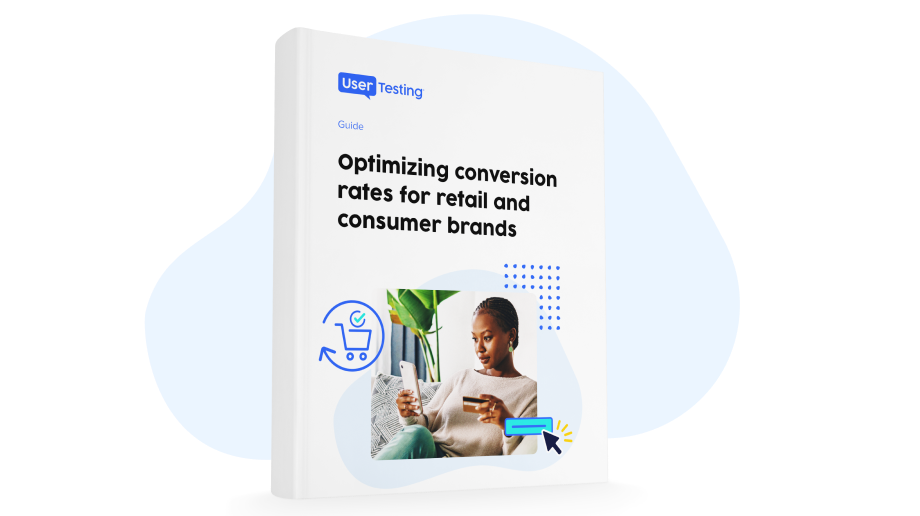
How to reduce cart abandonment rate

Loss of revenue caused by cart abandonment is one of the most frustrating pain points for an ecommerce business. The average rate of cart abandonment is 70%, according to the Baymard Institute, equating to a loss of about $18 billion in annual sales revenue.
But luckily, it’s not all bad news. While every retail website has its fair share of window shoppers, lurkers, and comparison buyers, there are steps you can take to reduce cart abandonment rate proactively.
For B2C organizations, the customer experience relies heavily on various digital touchpoints. Optimizing your shopping experience across channels and devices can significantly reduce cart abandonment and improve your customers' overall shopping experience.
By adopting UX best practices and usability testing, your organization can empty abandoned carts and regain control over conversions. It's all about taking the following steps:
- Optimize a customer's path to purchase
- Design a checkout process that gains trust
- Ensure your experience is convenient and enjoyable for shoppers
One of the biggest reasons customers abandon their carts is friction in the buying process—whether it’s unexpected costs, complicated checkout flows, or a lack of payment options. Addressing these pain points requires a data-driven approach that identifies where and why users drop off. Gathering direct customer feedback through usability testing can help uncover hidden frustrations, allowing you to fine-tune every aspect of the journey. From streamlining form fields to offering guest checkout and displaying clear pricing upfront, small changes can have a big impact. By continuously testing and optimizing, you can turn hesitant shoppers into loyal customers and recover lost revenue.
Marketing insights
Discover how UserTesting helps marketers refine messaging, optimize campaigns, and drive stronger customer connections.
To see human insight in action, watch the highlight reel below. See what it’s like to get video feedback from everyday consumers as they shop your brand and give feedback on CTAs, navigation, the checkout process, and more.

What is cart abandonment, and what causes it?
Shopping cart abandonment occurs when customers leave the ecommerce website before completing the purchase. The cart abandonment rate defines the ratio between visitors who complete the purchase and those who fail to complete the checkout process.
According to a recent Statista report, the average ecommerce conversion rate is 1.8%, and about 98% of visitors globally fail to complete their purchases.
If your ecommerce organization struggles with cart abandonment, identifying friction points is a good place to begin and ultimately reduce cart abandonment.
Common friction points leading to cart abandonment
- Hidden costs: While a product page may offer one price that a customer is comfortable with, one may not be happy to find that when they’re ready to check out, extra fees and costs are suddenly visible. 55% of shoppers abandon carts for this reason, according to Dynamic Yield.
- Unclear or lengthy checkout process: Customers want the online retail experience to be quick and seamless, like checking out in-store. If there are too many pages to get through or a site requires unnecessary information, customers can be clicks away from leaving for a competitor.
- No guest checkout option: As a customer, you’ve likely experienced being close to checkout only to find out that you must sign up for another account. Offer shoppers more flexibility with an effective guest checkout design, and have them sign up for an account on their terms.
- Limited payment options: In person, customers have plentiful payment options, from digital wallets and contactless payments to cash or cards. Online stores need diverse options to replicate this flexibility or risk losing a customer.
- Need for more shipping options: If you look at top retailers, many offer standard shipping, expedited shipping, or a buy online, pick up in-store option. While you can’t always guess your customers’ preferences, you can correctly assume they want options and the freedom of choice.
- Slow-loading pages: While not all shoppers may be in a hurry when shopping online, we can all agree that no one wants to wait on a slow-loading page.
- Lack of consumer trust: Shoppers hesitate to share their credit card details and personal information on a site they don't trust. If you fail to convince your customers that you will protect their data and identity, they’ll most likely abandon your ecommerce site without making the purchase. 17% of consumers cite this factor as a cause for abandonment.
6 tests to reduce cart abandonment
1. Consumer trust and confidence
Shoppers want to know whether your site is safe and whether their data is safe with you. Lose customer confidence, and you might lose your sale.
Increase conversions by maintaining your customer’s trust and confidence throughout the checkout process. Find out what security information is important to customers and whether they can easily find it.
Ask shoppers:
- Do you trust this site or app? Why or why not?
- How confident are you in providing this company with your financial and contact information?
- Is it important for you to see third-party verifications?
- Do you pay attention to privacy policies? Explain your answer.
- Is there an organization that you trust more? Why do you trust them more?
Use this test type:
Opt for a classic unmoderated test. Structure your tasks around a hypothetical checkout process, and ask your test participants how they assess the site or app security.
Use this template:
Optimize data privacy for transparency, accessibility, and trust—and pinpoint all friction points customers may encounter.
ON-DEMAND WEBINAR
Winning repeat customers: How retailers can optimize every digital touchpoint for more conversions
In this webinar, you'll learn:
- How to uncover hidden obstacles driving bounce rates
- Common customer frustrations crushing loyalty and repeat purchases
- Actionable strategies to reduce friction and enhance trust during online purchases
2. Return policies and guarantees
Brick-and-mortar shoppers know they can talk with an employee if things go awry with their purchase or if they change their mind. Online shoppers need a similar safety net.
Ask your participants to find your return policy (and perhaps your satisfaction guarantee, price match guarantee, etc.), and ask them whether it’s easy enough to find and whether they have any concerns or fears that haven’t been addressed.
Ask shoppers:
- Are you able to find information about returns and exchanges?
- How do you feel about the return and exchange policy?
- Does a return policy affect your perception of a business or motivation to purchase? Why or why not?
Use this test type:
For your study, consider asking a customer to go through an actual return process with an ecommerce organization. Since this may not be completed in one study alone, consider a diary or longitudinal study that evaluates habits, prolonged processes, and perception changes over time.
Use this template:
Understand how customers engage with your site throughout their entire journey, including returns and exchanges.
3. Customer service experience
Some shoppers find comfort in the immediate availability of customer support. These types of support may be more than just FAQs and knowledgebases but real people or chatbots ready to talk.
Consider asking your participants whether they know how to get help if they need it and what their preferred support method is. You might find that adding a phone number, chat button, or a 24/7 support icon gives shoppers the confidence to continue checking out even if they never end up needing support.
Ask shoppers:
- What’s the first thing you look for after receiving an order you placed online or through an app?
- Do you feel you have enough information to follow up with customer service after making a purchase?
- Who should you contact if you have questions or concerns about your order?
- Do you prefer to place orders during business hours if you need customer service?
- Does 24-hour customer service influence your perception of a brand?
Use this test type:
A live conversation or a moderated test is sufficient to learn how customers prioritize customer service. A live conversation offers more opportunities to dig deeper, especially if you want to walk through the ecommerce experience alongside your test participant.
Use this template:
See how your customer service compares to a competitor's by conducting a comparison study. You’ll understand what people prefer and why.
Competitive comparison template
4. Price and value perception
Online stores must combat the challenge of their competitors’ prices being just a browser tab away. If the customer has reason to question the value they’re receiving, nothing stops them from leaving you for another brand.
Highlighting any applicable sales prices, shipping discounts, and total savings increases confidence in the value the customer is receiving. You may lose customer confidence if you reserve shipping costs, taxes, and other fees until the last page. You might also show your potential consumers a low-price guarantee to see the impact on their buying confidence.
Ask shoppers:
- Is the total price of your order clear?
- How important is the coupon code field to you? Explain your answer.
- How does price impact your purchasing decision?
- Where do you go to compare prices and products?
Use this test type:
Consider an unmoderated test to assess how your customers feel about pricing and value, and set up tasks to walk them through product pages and the checkout process.
Use this template:
Gain further insight into what customers think and expect during an uncertain market and how it impacts their shopping habits.
Pricing and customer perception template
5. Ease of use
The convenience of your checkout process can’t be verified by analytics alone. Your customer might get from page one to page three quickly, but did they accomplish everything they wanted to, and did they hit any confusing points along the way?
Qualitative testing is the next logical step when your quantitative data shows there’s a problem.
Ask shoppers:
- How could we have made this faster, more convenient, and easier for you?
- Did anything frustrate you during the checkout process?
- If you had to make this purchase again, would you use this store or a different one? If you’d use a different one, why?
Use this test type
An unmoderated test is ideal to asses general usability and pinpoint any major areas of friction within the checkout process. Most usability issues can be discovered with a small sample of users, so this type of test can be run quickly and as often as needed.
Use this template
If you're testing a web experience, try the website evaluation template, which assesses general usability for characteristics like appearance, ease of use, and trust.
6. Mobile experience
Mobile shoppers have the highest cart abandonment rate, at 86%, compared to 70% of desktop shoppers, according to the Baymard Institute.
To ensure a consistent ecommerce experience across devices, prioritize running mobile tests on your checkout process so that customers don’t encounter any issues when interacting with small screens.
Ask shoppers
- Do you prefer checking out on mobile or desktop? Why?
- Is the checkout process consistent across channels or not?
- What would compel you to check out on mobile more?
Use this test type
Consider an omnichannel study or multichannel test to test consistency across all devices. Opt for omnichannel testing if you want to test a single process that spans multiple devices. You're better suited for multichannel testing if you want to test the same process on various devices.
Use this template
Assess critical app characteristics like appearance, ease of use, and trust.
Mobile app evaluation template
Create a shopping cart that’s hard to abandon
While the top reasons for abandoned carts may shift with time, what you can count on is customers wanting a checkout process that’s upfront, quick, flexible, and trustworthy. Shopping cart abandonment may be a major concern for ecommerce teams, but with the help of consistent customer insight and usability testing, it no longer has to be a mystery.
By regularly connecting with ecommerce shoppers to understand their needs and frustrations, from pre-launch to post-purchase, teams can eliminate friction points before they occur.
Collecting human insight ultimately reduces cart abandonment and leads to better customer shopping experiences, increased sales and conversions, and enhanced customer loyalty.

Optimize conversion rates
Accelerate growth and streamline operations by crafting frictionless ecommerce experiences that exceed customer expectations.





